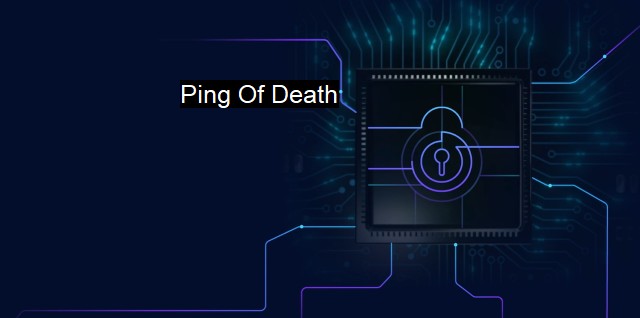What is Ping Of Death?
Ping of Death: The Dangerous Network Attack Exploiting IP Protocol Vulnerability
"Ping of Death," referred to as PoD, is a term that emerged from the cybersecurity field, and it is a technique incorporated for nefarious reasons by intruders looking to exploit weaknesses in any computer system or network resource. Generally, PoD is associated with Denial of Service (DoS) attacks, a form of cyberattack primarily designed to render any systems, servers, or network resources unavailable to the intended users.Understanding Ping of Death requires some understanding of its terminology. 'Ping' is a standard networking tool available on almost all operating systems. Its primary role is to confirm connectivity, available on the network, while providing the functionality of measuring the time between transmission and reception, usually expressed as "Ping Time." Conversely, 'Death' represents the harmful event engendered by the attack.
The PoD attack manipulates the Internet Control Message Protocol (ICMP), a service utilised for delivering error messages across network devices. The protocol also helps different devices detect and report any connectivity-related issues, transmitting packets containing information about system statuses encountered by them.
In a regular ping operation, ICMP sends packets called echo requests to a target machine, which sends back echo replies. The acceptable ping packet size specified by the Internet Protocol (IP) is 65,535 bytes. most systems cannot handle a data packet of this size. A typical MAC system limits packets to 1500 bytes, and anything above the MTU size is fragmented into smaller packets to enable the transmission.
This is where the Ping of Death exploits a vulnerability. An attacker leveraging the PoD attack sends oversized or malformed ICMP packets, more substantial than 65,535 bytes, forcing a system to malfunction or be overloaded. Since systems are not designed to handle large packets, they often fail in their attempts to put together a packet of extreme size. Consequently, they tend to crash or reboot, leading to interruptions in service.
It's important to mention that these types of attacks maliciously involve sending massive amounts of data in one packet. Therefore, the buffer reserved for each packet's storage cannot contain the excess data, which leads to a "buffer overflow." Buffer overflow is a standard cybersecurity attack that causes data corruption, application malfunction, and system crashes.
The era when the Ping of Death attacks was proliferative was during the mid-to-late 1990s, causing severe problems to Windows 95, Windows NT, and UNIX systems, among others. modern systems have been designed and patched to defend against these attacks, making Ping of Death more of an understanding piece in cybersecurity education than a considerable threat today.
a robust antivirus software programmed to monitor and prevent such attacks stands to be a shield against PoD attacks, guiding against potential contagions affecting software performance, data integrity, and system reliability.
In the cybersecurity landscape, understanding the aspects and mechanisms of attack types such as PoD opens insights into dealing with the evolving vulnerabilities and threats better. Even so, the Internet's flexible nature necessitates complete, exhaustive cybersecurity preparedness against current and emerging threats for both individuals and businesses.
Ping of Death reveals the adaptive nature of cyber-attacks. Over the years, as network protocols evolve and system vulnerabilities are patched, the attack methods alter imminently. Herein, security systems must also adapt to these changes, advancing in defending against new-age threats. In the meantime, so long as the internet continues to bind us, awareness about cyber threats like PoD and knowing the practices that best ensure protection against them is liberating, as it is pragmatic.

Ping Of Death FAQs
What is a ping of death?
A ping of death is a type of cyber attack that involves sending an oversized and malformed ping packet to a computer or network device. The attack can cause the target system to crash, freeze, or behave erratically.How does a ping of death attack work?
A ping of death attack works by exploiting a vulnerability in the way the target system handles oversized packets. The attacker sends a ping packet that is larger than the maximum allowable size, causing the target system to crash or hang.What can I do to protect myself from a ping of death attack?
To protect yourself from a ping of death attack, you should ensure that your system is patched and up-to-date with the latest security updates. You can also use a firewall to block ping requests and other types of potentially malicious traffic.Can antivirus software detect and prevent a ping of death attack?
Yes, antivirus software can detect and prevent a ping of death attack by identifying and blocking the oversized and malformed packets used in the attack. However, it's important to keep your antivirus software up-to-date to ensure that it is capable of detecting new and emerging threats.| | A | | | B | | | C | | | D | | | E | | | F | | | G | | | H | | | I | | | J | | | K | | | L | | | M | |
| | N | | | O | | | P | | | Q | | | R | | | S | | | T | | | U | | | V | | | W | | | X | | | Y | | | Z | |
| | 1 | | | 2 | | | 3 | | | 4 | | | 7 | | | 8 | | |||||||